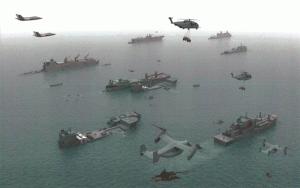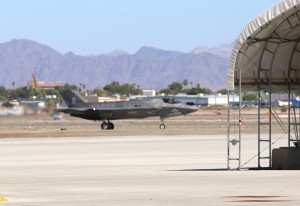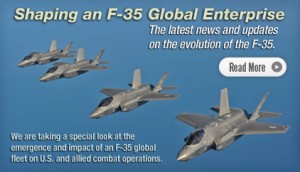2014-07-23 It is clear from much of the policy discussion surrounding the F-35 that it is difficult for folks to wrap their minds around what a global support structure might look like. What also makes the discussion difficult is to understand what a F-35 fleet deployed on national territories, on ships or in forward points of operations means in terms of a global support structure.
The F-35 is a 21st century air system, and as such shares the combat space with both legacy and 21st century systems and any global enterprise support structure will be decisively shaped by changes in global commercial logistics as well.
The depot structure of the Pentagon is largely out of sync with globality or expeditionary reach but can be significantly modified to adapt to changing global conditions.
But is not the F-35 global enterprise, which should be bent to conform to a 20th century depot logistics management system; it is the other way around.
Drivers of Change
There are a number of fundamental drivers of change associated with the coming F-35 fleet that will alter the environment within which the logistics enterprise needs to be re-shaped.
First, there are simply the physical aspects of how the plane is manufactured. This is the first fighter aircraft ever built with common parts stamped throughout the plane with an information management system, which can manage the parts throughout a global supply chain.
What is done with this capability is a function of how organizations take advantage or not of such a capability. Notably, the A400M is built with common UIDs built in, and the question remains whether the various European MODs will take advantage of this commonality and an IT system to manage the parts from a broader perspective than the national Air Force.
Economies of scale, security of supply and improvements in the parts themselves can all be facilitated by the ability to “see” each part, where it comes from and how it performs.
But if the logistics bureaucracy simply operate as bottle necks to the flow of the information to the prime contractor, then the ability to improve the supply chain as planes are built, improved and produced will be undercut.
This is as true for an A400M as it is for the F-35.
Put in blunt terms, the governments can blame themselves for driving up costs, and reducing reliability by over-bureaucratizing the “management” of the supply chain.

Building, deploying and operating 21st century combat aircraft is not a government jobs program; it is about winning the unfair fight in combat situations.
Second, there is a strategic shift from linear air operations FROM bases to expeditionary air operations in engagement areas. This means that the ability to operate aircraft in a variety of conditions, which will not see a lot of prepositioned equipment, will be more frequent for 21t century operations. Depots will be a long way away from the engagement area.
It will not be about building Wal-Mart’s and then providing support to combat aircraft and support aircraft. It will be about the ability to operate forward.
For example, the Marines are engaged in a significant shift in the Pacific referred to as the distributed laydown and the USAF in the Pacific is working in distributed operations as well. These efforts work only with effective expeditionary logistics able to operate in support of an engagement force.
Again, depots are a long way away. This is not an aberration but a trend.
Third, littoral operations using 21st century equipment will be a key requirement for U.S. global policy in the period ahead.
And working through how to support those new capabilities at sea is a key aspect of the change. It is no accident that the USS America, the largest amphibious ship ever built and designed to maintain Ospreys and F-35Bs at sea, will see the VMX-22 squadron come onboard precisely to work on how Ospreys can be maintained effectively at sea aboard the new ship.
And clearly working on how commercial methods can be leveraged to better do at sea maintenance and heighten operational effectiveness is crucial as well.
In a recent interview with the head of the Military Sealift Command, Admiral Shannon, highlighted that loading functions of MSC lagged significantly behind how the commercial fleets did global loading. He asked simply: Why?
The answer clearly is because DoD does not do it that way. This gap between commercial and defense applications is crucial to overcome to deal with the sustainment challenges facing 21st century systems, including the F-35.
A final driver for change is very tough for the Department of Defense to recognize. Although the F-35 is a U.S. aircraft, it has significant foreign content and has a global network of suppliers.
Yet it is not for a fleet of U.S. airplanes; it is for a fleet of global airplanes. The U.S. is not rolling out F-35s at anticipated rates in its own forces, which will lead to the USAF having to compete with the roll out to foreign Air Forces.
Neither DoD policy makers nor the Congress have fully appreciated the impact of concurrent deployments of advanced aircraft. This means that core allies are on the ground floor of shaping a sustainment system for the global fleet of F-35s.
As one Australian supplier to the F-35 and to commercial aircraft put it: “The F-35 is the military equivalent of the A-320 in terms of populating the fleets of global users.”
A Way to Look at the Challenge: The Australian Case
Australia is an expeditionary case all and in of itself. For the RAAF to operate anywhere in Australia, it has to cover vast distances. And when it flies to an engagement in the Pacific or elsewhere, logistics shortfalls is a constant problem.
According to Vice Air Marshal (Retired) Jon Blackburn, Australia needs a just in case rather than a just in time logistics system. Being on the other side of the world means that the RAAF needs security of supply as well as cost effective approaches to providing for that supply.
The RAAF is clearly committed to F-35 but worries about how the logistics system will operate in conjunction with its overall approach.
According to Blackburn:
What are the implications of a changing model for logistics support as exemplified by the Joint Strike Fighter (JSF) and its global supply chain approach?
The commonality of spares across the supply chain means that you do not necessarily own all the parts yourself.
It is a neat economic concept, but because it is not built yet, there is no evidence of how it is going to work in a contingency.
How do you build an information system to support the new logistics support model and interface with an old style of supply chain management?
Integration does not seem realistic, but interoperability is the key word in this case.

The builder builds a platform/product, but it is not their responsibility to make the overall defense system work.
The maintenance aspects of the contract are competed.
What is changing right now is the construct of owning your spares and defining a contract and support service in-country, while you are part of a global supply chain.
In the case of the JSF, Lockheed Martin is in charge of a global supply chain based on shared spares. The fighter is part of a much bigger supply chain managed by a system called ALIS (autonomous logistics information system).
The system is managed as a global entity, not as an “Australian stovepipe”. So what you are talking about is a change in the concept of support logistics, as a result of the change in technology.
How do you interface with a legacy logistics system such as that in Australia is still unclear.
Will we have to manage each of these lines as separate supply chains with their own information system?
How do we aggregate that to make it work is the second question.
So we have to do some systems analysis and risk assessment in terms of our defense preparedness.
Until recently, you used to have much more control; it was a slow and imperfect system, but you had control over it and you knew what you had; stocks were yours and you could measure the pace of replenishment.
The IT systems were designed for that and fit the Australian needs.
We cannot turn back to the old ways of doing business, so we have to be interoperable.
There are advantages, and we could probably not afford the JSF otherwise, so the question is how do you plug into legacy systems, which were never designed to operate that way at all and what is the impact on our preparedness and supply chain’s availability assessment.
We have to think of it as a “Fifth Generation” logistics system trying to operate with a Third generation logistics infrastructure!
The JSF is not only a Fifth Generation platform, it is also a Fifth Generation logistics system. Managing the supply chain is paradoxically at risk of becoming more complex and more compartmentalized by fleet than in the past.
The advantage of Blackburn’s analysis is that the RAAF needs to adapt its approach in order to be able to operate the F-35 as a key element for its overall expeditionary capability.
The challenge for the USAF is that they need to reach the same conclusion as Blackburn and that solutions which countries like Australia come up with as part of the overall F-35 program will be as significant as the USAF approach.
The USAF will have to demonstrate leadership in logistics innovation; not simply assume that THEY will define the global approach all by themselves. The others will not wait and will use an aircraft, which they believe is essential to their national survival.
Shaping the Way Ahead: The USMC, the USAF and Allied Air Forces as Initial Drivers of Change
It is odd that the Marines, not primarily defined by airpower, are at the center of innovation with regard to the way ahead with the F-35. They are because they are getting the plane first, have no other combat aircraft on offer, and have gone through the gut wrenching Osprey transition.

The Osprey turned out not to be a replacement for the CH-46; its was a shaper of a new USMC, one that is tiltorator enabled. It is the only tiltrotar assault force in the world; an innovation, which is far beyond anything the USAF or USN, has gone through over the past decade.
The Marines are in hurry to get the planes to Asia and to assist in their challenge redeployment in the Pacific. Combat packages are going to be so disaggregated and so distributed, that without the F-35 as a connector and battlespace protector and enabler, the Marines are at risk.
Getting the F-35B to work and be sustained at the point of attack is not a nice to have quality it is a bedrock quality for the MEUs and MAGTFs to operate effectively and prevail.
This was clear from the recent visit of the Second Line of Defense team to Yuma Air Station and visits with MAWTS-1 and VFMA-121. Because the amphibious ship is the definer of what a sustained asset really is to the Marines, the marriage of the F-35B to the large deck amphibs will be the measure of success, progress or failure for the logistics enterprise.
The USS American can provide a solid platform from which to work the logistics effort and then work backwards to the rest of the fleet. But working backwards to the rest of the fleet will be a major effort for the decade ahead.
And because allied Air Forces, especially in Pacific, have a sense of urgency about their role in national survival, they will become the natural allies of the Marines. Again, this is not the usual pattern where the USAF leads, and everyone else follows, but this will be the case in part because the Marines have the same sense of urgency that allied air forces have in the Pacific.
It is clear from discussions at Yuma that the Marines are working closely with the USAF and of course with the USN in rolling out the F-35.
But because the USMC and USAF along with foreign air forces are early users of the aircraft, this triad will drive the forging of a global system to support the F-35.
For regular updates on the F-35 and shaping a global enterprise see the following:
https://www.sldinfo.com/category/issues-trends/f-35-global-news/

Editor’s Note: For selected earlier pieces looking at the global fleet concept:
https://www.sldinfo.com/starting-an-industry-from-uid-to-rfid/
https://www.sldinfo.com/the-f-35-the-impact-of-a-global-fleet/
https://www.sldinfo.com/the-f-35-the-impact-of-a-global-fleet/
https://www.sldinfo.com/a400m-the-fleet/
https://www.sldinfo.com/an-update-on-airbus-military-may-2012/


